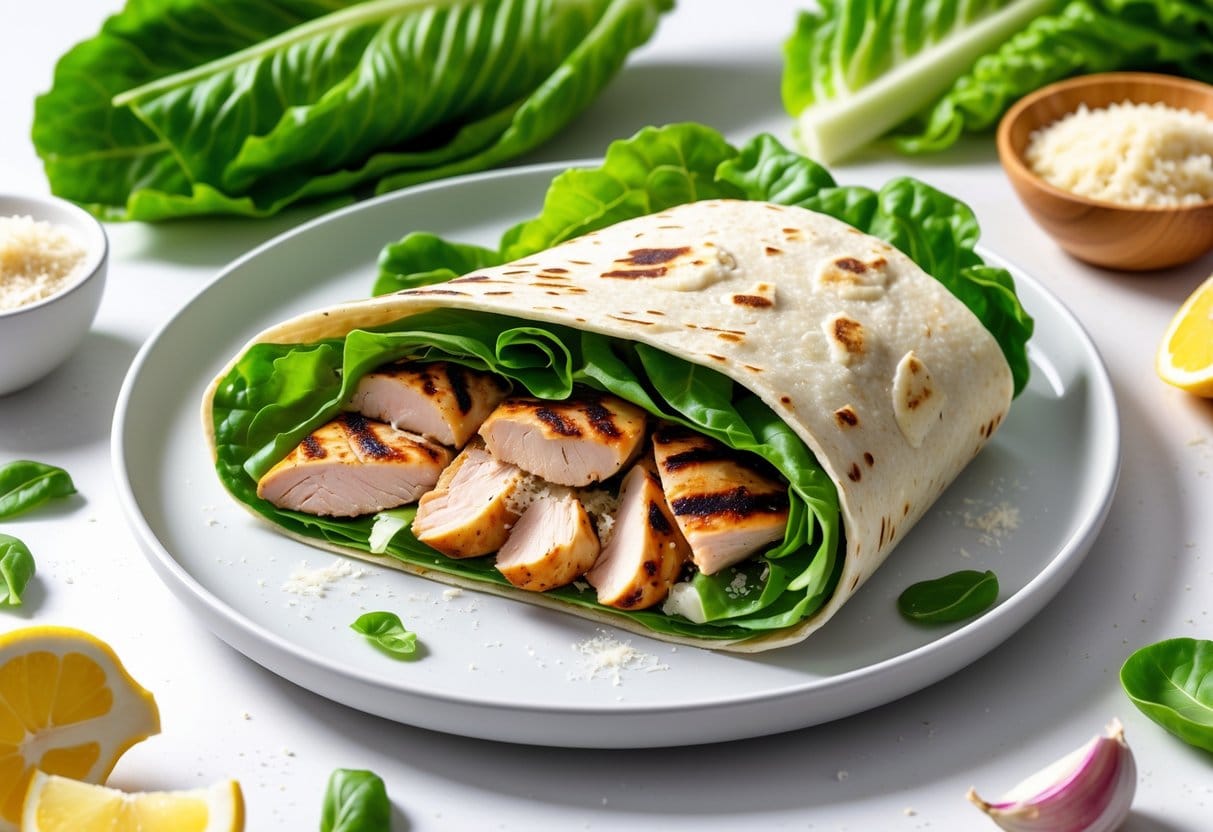Chicken Caesar wraps are pretty convenient and, honestly, they taste good. They’re usually safe to eat as long as you’re using fresh ingredients and handling them the right way.
Like with any grab-and-go food, you’ve got to store and prep them carefully—especially if there’s mayo or cooked chicken involved.

Some chicken Caesar wraps can sneak in extra calories and fat, depending on what’s inside. Occasionally, you’ll see recalls for safety reasons, so it’s not a bad idea to check for recent alerts.
Paying attention to ingredient quality and storage just makes the whole experience less stressful.
Key Takeaways
- Freshness and proper handling make chicken Caesar wraps safer.
- The wrap’s healthiness depends on ingredients and how it’s made.
- Check for recalls if you want to avoid surprises.
Assessing the Safety of Chicken Caesar Wraps
When you’re picking out a chicken Caesar wrap, focus on the quality of what’s inside, the risk of foodborne illness, and how everything’s stored. All of that plays into whether you can eat it without worry.
Key Ingredients and Their Safety
A typical chicken Caesar wrap has cooked chicken, lettuce, Caesar dressing, and a tortilla. Chicken’s got to be fully cooked—undercooked chicken is a real gamble.
Lettuce should be washed well to get rid of dirt and anything else you don’t want to eat.
Caesar dressing sometimes has raw or barely cooked egg, which can be risky if not handled right. If you’re buying pre-made dressing, check the label, especially if allergies are a concern.
The tortilla? Usually safe if it’s not stale or stored wrong. When everything’s fresh and handled with some care, you’re in good shape.
Risk of Foodborne Illness
There’s a bit of risk if the wrap isn’t made or stored properly. Chicken is notorious for carrying bacteria like Salmonella or Campylobacter.
Cross-contamination is a real thing—keep raw chicken away from everything else.
If your wrap sits out at room temperature for more than a couple hours, bacteria can multiply fast. Eating something left out too long is just asking for trouble.
The risk drops a lot if you make it yourself or buy from a place you trust.
Proper Storage and Handling of Ingredients
Storage matters—keep your wrap or its parts in the fridge at or below 40°F (4°C). Leaving it on the counter for hours isn’t a good move.
If you prep or buy ahead, aim to eat it within a day or two. Keeping lettuce separate until you’re ready to eat helps keep things crisp.
Reheating? Make sure the chicken hits 165°F (74°C) to kill off bacteria. Don’t refreeze leftovers; it’s just not worth it.
Ingredient-Specific Concerns
Some ingredients in a Chicken Caesar Wrap need a closer look. If you’ve got allergies or are picky about food safety, these details matter.
Chicken Quality and Preparation
Chicken safety comes down to how it’s cooked and stored. Always cook chicken to at least 165°F (74°C)—anything less is risky.
If you’re buying pre-made wraps, check the expiration date and how it’s been kept.
Chicken that looks weird or smells funky? Skip it. Refrigeration is your friend here.
Potential Allergens in Caesar Dressing
Caesar dressing can hide allergens you might not expect. Anchovies, for example, are common in Caesar and can be a problem if you’re allergic to fish.
Parmesan cheese can be an issue for people who are lactose intolerant or allergic to dairy.
There have been recalls because the fish content wasn’t labeled. If you have allergies, double-check the ingredient list before digging in.
Understanding Recalls and Precautionary Measures
Sometimes, chicken Caesar wraps get recalled for undeclared allergens or contamination. It’s good to know what’s going on so you can avoid any nasty surprises.
Recent Ingredient Recalls
A few chicken Caesar wraps have been recalled lately for different reasons. Most of the time, it’s because of undeclared allergens, like eggs in the dressing, or because of Listeria contamination.
One company pulled about 1,784 pounds of wraps since the dressing had egg but the label didn’t mention it. Another recall was for nearly 300 pounds due to misbranding and missing allergen info.
Contamination recalls usually pop up if Listeria is found during testing. If you’re worried, check your lot numbers or reach out to the manufacturer for details.
What to Do if Your Product Is Recalled
So, you just found out your chicken Caesar wrap’s been recalled. First thing—don’t eat it.
Seriously, eating recalled food can lead to allergic reactions or even infections. It’s just not worth the risk.
Take the wrap back to where you bought it. Most places will give you a full refund, and usually you don’t even need a receipt.
Keep checking for updates from stores or agencies like the USDA. They’ll let you know what to do next, or how to toss the food safely if you can’t return it.
Better to play it safe than end up sick, right?